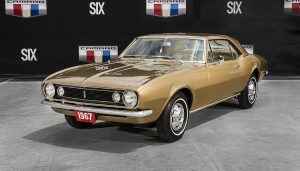1970 Plymouth Hemi Superbird
If you can’t conjure an image of this one in your mind just flash back to James Dean in a Rebel Without a Cause. We included the Mercury because of its iconic look and its reputation as one of the most modified cars Americans ever owned. It seems like owners, whether they bought the ’49 new or used couldn’t keep their hands off it.
The result was a removal of excess chrome, frenched headlights and taillights, severe lowering of the suspension, even hacking off the roof. Every owner wanted a personalized ride and the coupe’s ominous profile with its sloping fastback roof and long hood delivered.
The ’49 Mercury coupe could quickly go from America’s feel good ride to a sinister almost wicked custom appearance. And it wasn’t just a wicked look. Under the hood there was a 5.7L V8 pumping out 350 hp, three-speed Turbo Hydra-Matic 400 automatic transmission, independent front suspension and live rear axle with Air Ride system, and four-wheel hydraulic brake system.
If you can find one of these icons, KBB estimates you will lay out $40,000 to $60,000 for the right to park it in your driveway.
1932 Cord L-29 Cabriolet
Classic designs, innovative features and reputedly smooth handling, the Cord L-29 Cabriolet launched during the Great Depression and ended its career with just 4400 units built. The Cabriolet bespoke of an era with its oversized front fenders, side fold up engine access panel, running boards, spare tire featured on the side of the body, wire wheel covers, white sidewalls and overall classic look that conjures up images of The Great Gatsby.
The L-29 had several innovative features including the first front-wheel drive and a complicated but functional electronic transmission. Powered by a Lycoming 125 hp engine it wasn’t the fastest in its class but it was easily one of the best looking.
Today you might find bits and pieces of the car offered up for as much as $35,000 plus of course the cost of restoration. A fully restored Cabriolet recently went for over $400,000.
1930 – 1940 Cadillac V16
In 1930 Cadillac, operating under the pressure of leadership, launched a limousine that encompassed two new ideas. Cadillac believed that their customers wanted an engine simultaneously more powerful and smoother than any other available and with several competitors examining V12 designs the obvious solution (at least to Cadillac) was to build bigger, specifically 6 cylinders bigger. The result was a 452 cu. in. V16.
Fortunately the auto style of the time called for long hoods and minimal rear ends so the appearance of the V16 meshed nicely with the sophisticated look of luxury cars of the time. Cadillac had one other advantage over the completion and that was GM’s decision to buy Fisher Body and Fleetwood Metal Body both outstanding carriage shops that actually dressed the raw V16 chassis. Most luxury manufacturers farmed out the finishing of their chassis giving Cadillac an advantage in delivery time by finishing their cars in-house. It also gave them options in design and they ended up offering no fewer than 70 different models to the public.
Despite the fact that the stock market crash of 1929 heralded the start of the Great Depression, Cadillac sold 2,000 vehicles (almost half the total sales the model would sell over the next decade) by June 1930 but that’s when the financial crunch took a real bite worldwide and sales plummeted. Over a decade the V16 sold only 4,112 vehicles ending in 1940 with a total of 50 units going out the door. Of course if you could find one of these today the price would probably be in the neighborhood of the total sales Cadillac realized for the V16 over 10 years.
Well that’s the list. There are easily a dozen or more models that could have been on it. When a country builds cars for over a hundred years there are bound to be unforgettable and rare vehicles but we will save those for another day.








